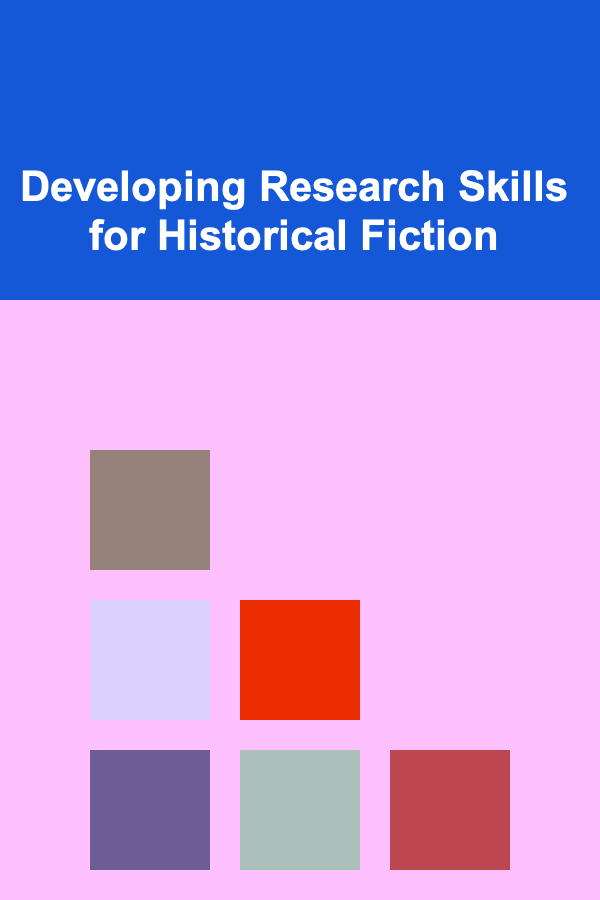
Developing Research Skills for Historical Fiction
ebook include PDF & Audio bundle (Micro Guide)
$12.99$8.99
Limited Time Offer! Order within the next:

Historical fiction, at its heart, is a delicate dance between imagination and reality. It demands not only creative storytelling but also a rigorous commitment to accurate and believable historical representation. The challenge lies in crafting a narrative that is both compelling and authentic, engaging readers while honoring the complexities and nuances of the past. To achieve this, a historical fiction writer must cultivate a robust set of research skills, capable of uncovering, analyzing, and interpreting the wealth of information that informs their work. This article delves into the essential techniques and strategies for developing these vital skills, providing a comprehensive guide for aspiring and established historical fiction authors alike.
Understanding the Scope of Research
Before embarking on the research journey, it's crucial to define the scope of your investigation. What period are you writing about? What specific themes, events, or social groups will your story explore? A well-defined scope acts as a filter, guiding your research and preventing you from being overwhelmed by irrelevant information. Consider these factors when defining your scope:
- Geographical Location: The specific location where your story takes place drastically impacts the cultural norms, political climate, and daily life that your characters would experience.
- Time Period: Even seemingly small shifts in time can result in significant changes in technology, social structures, and popular beliefs. Narrowing your focus to a specific decade or even a specific year can make your research more manageable and precise.
- Social Class: The lives of peasants differed dramatically from those of nobility. Consider the social standing of your characters and research the specific challenges and opportunities they would have faced.
- Key Themes: Identifying the central themes of your story -- such as war, love, religion, or social reform -- will help you prioritize your research efforts.
Once you have a clear understanding of your project's scope, you can begin to identify the specific research questions that need to be answered. These questions will serve as a roadmap, guiding your exploration and ensuring that your research remains focused and purposeful.
Mastering Primary Sources
Primary sources are the bedrock of historical research. These are firsthand accounts and artifacts created during the period you are studying. They offer direct insights into the thoughts, feelings, and experiences of people who lived in the past. While interpreting primary sources can be challenging due to biases and contextual limitations, they provide an unparalleled window into the historical period.
Types of Primary Sources:
- Letters and Diaries: These personal accounts provide intimate details about daily life, relationships, and individual perspectives on historical events.
- Official Documents: Government records, legal documents, treaties, and census data offer valuable information about political structures, laws, and demographics.
- Newspapers and Periodicals: Contemporary news reports, editorials, and advertisements provide insights into public opinion, current events, and social trends.
- Photographs and Artwork: Visual sources offer powerful representations of the past, capturing landscapes, buildings, fashion, and social interactions. However, remember that even these can be interpreted through a specific lens.
- Maps: Historical maps reveal geographical boundaries, transportation routes, and settlement patterns.
- Oral Histories: Transcribed interviews with people who lived through a particular period can provide invaluable firsthand accounts, particularly for underrepresented voices.
- Artifacts: Clothing, tools, furniture, and other objects offer tangible evidence of material culture and daily life. Visit museums or online collections for valuable insights.
Strategies for Working with Primary Sources:
- Transcription: Transcribing handwritten documents can be time-consuming but allows you to engage deeply with the text and identify subtle nuances.
- Contextualization: Always consider the author's background, purpose, and intended audience when interpreting a primary source. What biases might have influenced their perspective?
- Critical Analysis: Don't accept primary sources at face value. Evaluate their reliability and accuracy by comparing them with other sources and considering the historical context.
- Multiple Perspectives: Seek out a variety of primary sources that represent different viewpoints. This will help you create a more nuanced and balanced understanding of the past.
Leveraging Secondary Sources
Secondary sources are analyses and interpretations of historical events and periods written by historians and other scholars. They provide valuable context, synthesis, and critical perspectives that can enrich your understanding of the past. While primary sources offer direct insights, secondary sources help you make sense of the broader historical landscape.
Types of Secondary Sources:
- Scholarly Books: In-depth analyses of specific historical topics, often based on extensive research and rigorous methodology.
- Journal Articles: Focused studies that explore specific aspects of history, often presenting new research or interpretations.
- Biographies: Accounts of the lives of historical figures, providing insights into their motivations, actions, and impact.
- Documentaries: Visual narratives that present historical events and perspectives, often incorporating primary source materials.
Strategies for Evaluating Secondary Sources:
- Author Credibility: Assess the author's expertise and qualifications in the field. Are they a recognized authority on the topic?
- Publisher Reputation: Consider the reputation of the publisher. University presses and reputable academic journals are generally more reliable than self-published works.
- Source Citation: Check the footnotes and bibliography to see what sources the author used and how they support their arguments.
- Peer Review: Look for peer-reviewed publications, which have been rigorously evaluated by other experts in the field.
- Date of Publication: History is constantly being re-evaluated and re-interpreted. Consider the date of publication and be aware of more recent scholarship that may offer new perspectives.
Utilizing Libraries and Archives
Libraries and archives are treasure troves of historical information. They offer access to a vast collection of primary and secondary sources, as well as specialized resources and expert guidance.
Library Resources:
- Books: Libraries hold a wide range of scholarly books, biographies, and historical fiction, providing a comprehensive overview of different historical periods and topics.
- Periodicals: Access to academic journals and magazines, both in print and online, allowing you to stay current with the latest historical research.
- Databases: Online databases provide access to a wealth of digitized primary sources, including letters, diaries, newspapers, and photographs.
- Librarians: Librarians are invaluable resources who can help you navigate the library's collections, identify relevant sources, and develop effective research strategies. Don't hesitate to ask for assistance!
Archival Research:
- Finding Aids: Archives typically provide finding aids, which are descriptive guides to their collections. These aids can help you locate specific documents and materials relevant to your research.
- Original Documents: Archives hold original manuscripts, photographs, and other primary source materials, offering a unique opportunity to examine historical artifacts firsthand.
- Expert Staff: Archivists are knowledgeable about the collections they manage and can provide guidance on accessing and interpreting historical documents. Contacting them before your visit can save you valuable time and effort.
- Respect for Preservation: Archives often have strict rules regarding handling fragile documents to ensure their preservation for future generations. Always follow the archivist's instructions carefully.
Embracing Online Resources
The internet has revolutionized historical research, providing access to a vast array of digitized primary and secondary sources. However, it's crucial to evaluate online resources critically and to be aware of potential biases and inaccuracies.
Reputable Online Resources:
- University Websites: Many universities have digitized their library collections and made them available online. These websites often offer access to primary source documents, photographs, and maps.
- Museum Websites: Museum websites often feature online exhibits, collections databases, and educational resources that can enhance your understanding of historical artifacts and cultural practices.
- Government Archives: Many national archives, such as the National Archives and Records Administration (NARA) in the United States, provide online access to digitized government documents and records.
- Digital Humanities Projects: Collaborative projects that use digital technologies to analyze and interpret historical data, often providing interactive maps, timelines, and other visualizations.
- JSTOR and Academic Databases: Paid subscription services (often available through libraries) that offer access to a vast collection of peer-reviewed academic journals and scholarly books.
Critical Evaluation of Online Sources:
- Website Authority: Evaluate the website's credibility by considering the organization or individual responsible for its content. Look for established institutions, reputable organizations, or recognized experts in the field.
- Source Citation: Check to see if the website cites its sources and provides evidence to support its claims.
- Objectivity: Be aware of potential biases or agendas that may influence the website's content. Is the website trying to promote a particular viewpoint or ideology?
- Date of Publication: Consider the date of publication and be aware of more recent scholarship that may offer new perspectives. Websites may not always be updated regularly.
- Cross-Referencing: Verify information found on one website by cross-referencing it with other reputable sources.
Developing Specialized Research Skills
Beyond general research skills, historical fiction writers often need to develop specialized skills related to their specific projects.
Language Skills:
If your story takes place in a foreign country or involves characters who speak a different language, learning the basics of that language can be invaluable. Even a rudimentary understanding can help you decipher primary source documents and gain a deeper appreciation for the culture and customs of the period. Consider learning key phrases, common greetings, and slang terms used at the time.
Paleography and Deciphering Old Handwriting:
Working with handwritten documents from past centuries can be challenging due to variations in handwriting styles and the use of archaic abbreviations and terminology. Developing paleography skills -- the ability to decipher old handwriting -- can unlock a wealth of primary source information that would otherwise be inaccessible. Online tutorials and handwriting manuals can be helpful resources.
Historical Fashion and Costume:
Clothing plays a significant role in historical fiction, reflecting social status, cultural identity, and technological advancements. Researching historical fashion and costume involves studying paintings, photographs, and surviving garments to understand the styles, materials, and construction techniques used in different periods. Pay attention to details such as fabrics, colors, accessories, and hairstyles.
Military History and Tactics:
If your story involves warfare or military conflict, researching military history and tactics is essential. Understand the weapons, strategies, and logistical challenges of the period. Consult military historians, study battle maps, and examine primary source accounts from soldiers and commanders.
Social Customs and Etiquette:
Social customs and etiquette varied significantly across different historical periods and cultures. Understanding the rules of social interaction -- such as how people greeted each other, dined together, or conducted business -- is crucial for creating authentic and believable characters and scenes. Consult etiquette manuals and social history books for insights into the social norms of the period.
Organizing and Synthesizing Research
Effective research is not just about gathering information; it's also about organizing and synthesizing that information in a way that is useful for your writing. Developing a system for managing your research notes, sources, and ideas is crucial for staying organized and preventing information overload.
Note-Taking Strategies:
- Digital Note-Taking: Use note-taking apps like Evernote, OneNote, or Google Keep to create and organize your research notes. These apps allow you to tag, categorize, and search your notes easily.
- Index Cards: A traditional method that allows for flexibility and easy rearrangement of information. Write key facts and quotations on individual index cards and organize them by topic or character.
- Spreadsheets: Use spreadsheets to track information about characters, events, and settings. Create columns for key details such as names, dates, locations, and sources.
- Mind Mapping: A visual technique for brainstorming and organizing ideas. Start with a central topic and branch out with related concepts and subtopics.
Citation Management:
Properly citing your sources is essential for academic integrity and for providing readers with the information they need to verify your research. Use citation management software like Zotero or Mendeley to organize your sources and generate citations in various formats.
Creating a Timeline:
A timeline is a valuable tool for visualizing the chronology of events in your story and ensuring historical accuracy. Create a timeline that includes major historical events, as well as key events in your characters' lives. Use online timeline tools or create your own using a spreadsheet or word processor.
Developing a Character Bible:
A character bible is a comprehensive document that outlines all the key details about your characters, including their physical appearance, personality traits, backstory, motivations, and relationships. This document can help you maintain consistency in your character portrayal and avoid plot holes.
Ethical Considerations in Historical Fiction
Writing historical fiction carries ethical responsibilities. It's important to treat historical figures and events with respect and to avoid perpetuating harmful stereotypes or misinformation. Consider the following ethical considerations:
- Avoiding Historical Distortion: While creative license is necessary, strive to remain true to the spirit of the historical period and avoid distorting facts for the sake of plot convenience.
- Representing Diverse Perspectives: Seek to represent the experiences of marginalized groups and underrepresented voices in your story. Avoid perpetuating stereotypes or appropriating cultural narratives without proper research and sensitivity.
- Acknowledging Uncertainty: Acknowledge the limits of your knowledge and avoid presenting speculation as fact. Be transparent about the choices you have made in interpreting historical events and characters.
- Respecting Cultural Sensitivity: Be mindful of cultural sensitivities when writing about different cultures and religions. Avoid making generalizations or promoting harmful stereotypes.
- Giving Credit Where It's Due: Acknowledge the sources that have informed your work and give credit to the historians and scholars whose research you have drawn upon.
The Iterative Nature of Research
Research for historical fiction is rarely a linear process. It's an iterative journey of discovery, where new information can lead you down unexpected paths and challenge your initial assumptions. Embrace the process of continuous learning and be prepared to revise your story as you uncover new insights.
As you write, you will inevitably encounter gaps in your knowledge or questions that need to be answered. Don't be afraid to pause your writing and return to your research. This iterative process will help you refine your story and ensure that it is both compelling and historically accurate.
Conclusion
Developing strong research skills is paramount for any aspiring historical fiction writer. By mastering the techniques outlined in this article, you can embark on your writing journey with confidence, knowing that you have the tools and knowledge to create a historically rich and engaging narrative. Remember that research is not merely a prerequisite to writing; it is an integral part of the creative process, enriching your understanding of the past and inspiring your imagination. Embrace the challenge, delve into the historical record, and let your research illuminate the story you are destined to tell.

Generate Recurring Revenue by Selling Pre-Trained Deep Learning Models
Read More
How a One-Page Website Can Help Your Startup Make a Big Impact
Read More
How to Use Music to Enhance the Atmosphere of Your Yard Sale
Read More
How to Understand Craft Beer Cellaring Techniques
Read More
How to Discover the Romantic Streets of Lisbon
Read More
How to Design a Self-Care To-Do List for Introverts
Read MoreOther Products

Generate Recurring Revenue by Selling Pre-Trained Deep Learning Models
Read More
How a One-Page Website Can Help Your Startup Make a Big Impact
Read More
How to Use Music to Enhance the Atmosphere of Your Yard Sale
Read More
How to Understand Craft Beer Cellaring Techniques
Read More
How to Discover the Romantic Streets of Lisbon
Read More